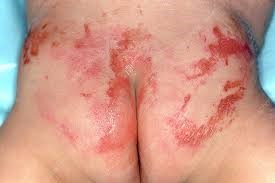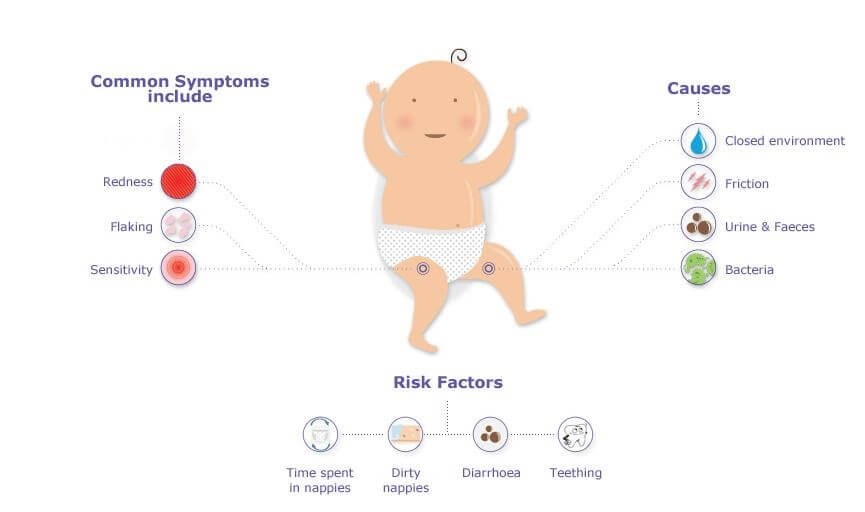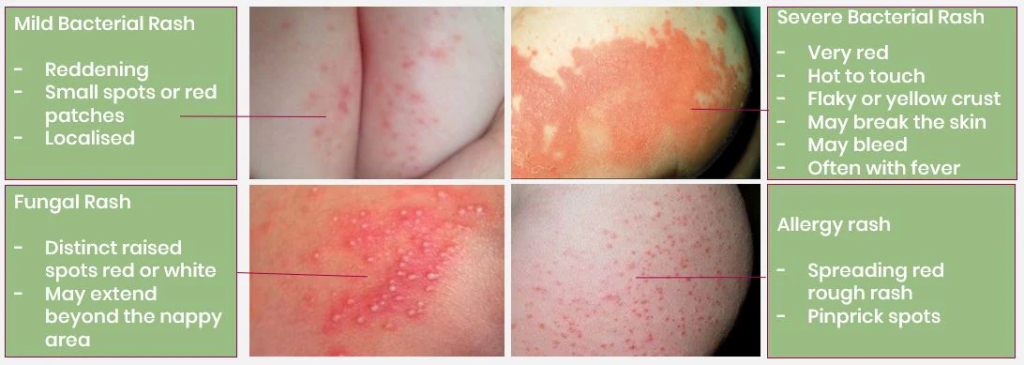Nappy Rash

What is nappy rash?
Nappy rash is a skin irritation around the area covered by the baby’s nappy. It can look like a mild pink or red rash just covering some of their skin, or across their whole nappy area. If left untreated, nappy rash can develop blisters and even open sores.

Some babies have skin conditions that make them particularly sensitive. Eczema, psoriasis and impetigo can make nappy rash worse because of a breakdown in the skin.
Nappy rash will affect 1 in 3 babies before the age of 2. There are things we can do to help avoid these rashes and to treat them if and when they do occur.
Signs and symptoms of nappy rash
The skin on the child’s bottom and genitals will look inflamed and sore. On children with darker skin, the inflammation might look brown, purple or grey. On children with lighter skin, the inflammation might look red. Some areas of skin might be raised or swollen, and there might be breaks in the skin. These breaks are called ulcers. Skin folds aren’t usually affected because wee doesn’t get into them. But nappy rash might sometimes go up onto the child’s tummy or spread up towards the baby’s back.
The rash can be uncomfortable and even painful, which can make the child irritable.

4types of nappy rash

- BACTERIAL
Most rashes are an irritation of the skin caused or aggravated by contact with the wee and poo. The rash starts with a slight reddening of the skin in the nappy area and can progress to soreness and discomfort.
- The most common type of nappy rash is a mild bacterial rash.
- The skin looks red and sore and can almost appear shiny.
- This is usually caused when the baby’s bottom is in contact with a wet or dirty nappy for a long period of time.
- A normal disposable nappy is made of plastic and traps heat and moisture inside. This combined with the wee or poo, makes a perfect breeding ground for bacteria.
2. FRICTION
Nappy rash can be caused by chaffing or rubbing if skin is very sensitive or the nappy is the wrong size.
- A common cause of nappy rash is friction caused by the nappy rubbing against the baby’s delicate skin.
- Whether the parents use disposables or reusable do check the fit of the nappy.
- It should be snug around the tummy but not too tight – parents should be able to fit their finger inside the waist band.
- The tabs should come around the sides and sit on the frontal sticky tape without having to cross over or meet – Most brands have a logo on their tape. Parents should sit be able to see this once the nappy is fastened.
- The leg ruching should not leave deep red indents in the babies’ skin. If it does, it is too tight.
- Conversely a too loose nappy can cause chafing between the thighs.
- Check the size chart on the nappies but remember every baby is different, so it may be a case of using the parents’ intuition.
3. FUNGAL
A bright red, moist rash with white or red pimples which spreads to the folds of the skin, may indicate that the baby has a thrush infection and requires a prescribed cream.
- This kind of rash can sometimes happen if the baby is on antibiotics or if they have thrush.
- A fungal rash shows as tiny red spots and the genitals can appear slightly swollen.
- This needs to be treated using an anti-fungal cream, available on prescription from the GP.
- This should be applied thinly to the affected area.
- If the nappy rash is fungal it is important that we avoid our usual barrier cream as this can make the condition worse.
4. ALLERGY
Occasionally nappy rash can become persistent and can be related to other skin conditions like eczema or allergies.
Some babies have sensitivities or allergies to the various components of their nappies or wet wipes.
Normal nappies are made using:
- Polypropylene
- Polyester
- Polyethylene
- Latex or PVC
- Chlorine bleached pulp
- Adhesives
- Dyes
- Perfumes
- Lotions
Prevention of baby’s nappy rash
Prevention is always better than treatment.
Parents can reduce the chance of their child getting nappy rash by keeping their nappy area clean and dry. Change the child’s nappy frequently and give their bottom air as often as we can. Parents also can :
- use good quality, disposable nappies
- try to leave the baby’s nappy off whenever possible. This will keep the baby’s skin dry and away from any contact with wee or poo. Try laying the baby on a towel during tummy time or any floor play. Parents should always watch that they have not wet or soiled the towel so that they are not left on a damp towel
- only use warm water to clean the rash area
- avoid soaps and perfumed baby wipes as these can irritate the skin
- use soft towels or cotton wool when drying the skin, and dab the area gently
- apply a barrier cream after changing every nappy. Products containing zinc cream, zinc oxide ointment and petroleum jelly are all suitable. You can also ask your pharmacist about nappy rash creams
- do not use talcum powder or antiseptics
When should the parents or caretaker see a doctor?
See a doctor if:
- the rash doesn’t clear up in one week
- there are blisters, crusts or pimples
- the baby has a fever
- the rash is spreading
- the baby is very upset
- if the parents have a son, the end of his penis is red and swollen or has a scab
The doctor or pharmacist may need to give patients a medicated cream to treat the nappy rash. If it is caused by eczema or a skin infection, the doctor will need to give the patients the right treatment.
References




